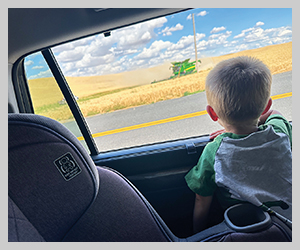Program seeks to develop leaders in natural resource sectors AgForestry Leadership Program
2023December 2023
By Trista Crossley
Editor

After nearly a half century of success, Washington’s vaunted natural resources leadership program, AgForestry, is taking a hard look at itself and its role going forward.
AgForestry was established in 1977 and designed to develop leaders in natural resource sectors. At the time, it was based on a similar program in California, and now, over 30 states have programs similar to the AgForestry Leadership Program. The program runs for 18 months and includes 11 seminars held across the state, a week in Washington, D.C., and two weeks in a foreign country. Each class, or cohort, represents a wide range of professions across the natural resource industries and is selected by an independent committee from an applicant pool. The program is overseen by a board of directors.

“There’s so few people left that operate and have expertise in natural resources that if we don’t have more people that truly understand, not just the natural resources sector they are in, but all of them, we could stand to lose so much,” explained Vicky Scharlau, AgForestry’s executive director since 2021. She’s an AgForestry graduate herself (Class 10).
Like so many other programs, COVID-19 shut AgForestry down for a year, and when the program returned, the board of directors recognized their target audience was shifting.
“Baby Boomers were slowly aging out, and the expectations and needs of the next generation were being made more obvious,” Scharlau said. A strategic planning process revealed the need for change, and the board hired Scharlau to help guide the organization. “The board wanted somebody who had done this before. I’ve been an executive director or worked in, for, or with nonprofits all my professional life. I know the landscape, and there were lots of really of hard decisions that were going to have to be made by the board.”
One of the first goals the board identified through the strategic planning process was to ensure that the program maintained its first-class status. The best practices to promote leadership development in adults have changed, and there is new technology to take into account. Using a grant from the Washington State Department of Agriculture, AgForestry is putting its curriculum through a formal evaluation process and developing ways to measure the program’s impact.
“We have to know we are meeting the needs of the employers and meeting the needs of the participants,” Scharlau said. “With this grant, we have the opportunity to look long and hard at who we are, the roles we play, and what the impact of the program is.”
AgForestry isn’t cheap. The current $6,000 tuition covers only the tip of the iceberg when it comes to actual expenses. Scharlau estimates that the program now costs more than $40,000 per person. In order to keep the tuition as low as possible, cuts were being made to the program to the point where, as she described it, “the fat was already gone, and we were cutting into bone.” The difference between the actual cost of the program and participants’ tuition is made up by outside contributions from alumni, commodity groups, and other sources.
“Part of what came out of the strategic planning process is we have to get this organization built up to the point where it should be, financially. We run two programs per year, so this is a million-dollar program, and we are trying to operate at half that. That’s not sustainable,” Scharlau said.
AgForestry’s ideal participant is someone with some professional experience under their belt who is willing to be vulnerable and willing to examine their own biases. Scharlau pointed out they aren’t necessarily looking for people who are already leaders, but for people who have the potential “to be bright and shiny.” She also explained that AgForestry isn’t a certificate program or a master’s program in leadership.
“You are not in it for a certificate. You are in it to go through change. You are in it for personal development. You have to be willing to have a personal paradigm shift,” she said. “What you get out of the program is based on what you put in. It is about your journey in leadership and the relationships you build with the other members of your cohort, because you will learn as much, probably more, from your cohort as you will from the seminars in a year and half.”
The seminars are grouped into three modules that each focus on a particular aspect of leadership: personal leadership, leadership in public policy, and leadership and systems thinking, and they all come together at the final Applied Leadership and Graduation seminar. The seminars build on each other and may include workshops, experiential tours, and speakers. For many participants, the highlight of the program is a two-week international trip that explores the inner workings of a foreign country (or countries) as it relates to natural resource management. When the program first started, international travel was much less common, and it was designed to pull participants out of their comfort zone. The current class, Class 44, will be traveling to Costa Rica and Panama.
One of the aspects that Scharlau said the program needs to address is increasing tribal participation, especially because they figure prominently in many of Washington state’s natural resource sectors. In fact, part of AgForestry’s origins lie in the “fish wars” of the 1960s and 70s between sport and commercial fishing industries and the Tribes.
For more information on AgForestry, visit the website at agforestry.org. Applications for the next class, Class 46, open next year.
“AgForestry will impact who you are, how you live your life, and the impact you make both personally and professionally more than anything else you’ve done,” Scharlau said. “If somebody comes into the program and they are really open and embrace developing as a leader — actively pursue that journey — they will come out a different person.”












